ERA Country Report 2023
Spain
Edited by Lucía Nájera (Ecorys)
as part of ‘Development of the ERA Scoreboard, the ERA Dashboard and the Regular Reports’ project for the European Commission, Directorate-General for Research and Innovation under Framework Contract N° 2018/RTD/A2/OP/PP-07001-2018 Lot 2 (EDAR)
Click here to download this country report![]()
- Table of contents
-
ERA Country Report 2023: Spain
1. National context
1.1. Overview of the ERA policy agenda implementation
1.2. Policy context
2. Assessment of the Implementation of the ERA Policy Agenda and ERA Priorities
2.1. ERA Priority 1: Deepening a truly functional internal market for knowledge
2.2. ERA Priority 2: Taking up together the challenges posed by the twin green and digital transition and increasing society’s participation in the ERA
2.3. ERA Priority 3: Amplifying access to research and innovation excellence across the Union
2.4. ERA Priority 4: Advancing concerted research and innovation investments and reforms
3. Country-specific drivers and barriers
4. Final remarks
5. Bibliography
6. Annexes
6.1. Annex 1: Graphs
ERA Country Report 2023: Spain
|
Key takeaways:
|
1. National context
1.1. Overview of the ERA policy agenda implementation
Spain is a Moderate Innovator according to the European Innovation Scoreboard (EIS), with a performance at 89.2% of the average for the EU in 2023. Despite its adherence to the ERA Policy Agenda and the implementation of research excellence programmes, the European Commission Semester report for Spain (2023) states that research and innovation (R&I) in Spain remain restrained both in the public and private sectors.
The Spanish strategy towards the implementation of the ERA Policy Agenda and subsequent priorities and actions involves different policy initiatives. Together with the Spanish National Recovery and Resilience Plan (RRP), the Spanish Strategy for Science, Technology and Innovation (EECTI) is the most comprehensive initiative for the 2021-2027 period. It encompasses an extensive range of policies ^ and is expected to increase R&I financing gaps. ^ The lines of action defined under this strategy are interlinked with the priorities defined under the ERA. The strategy covers the priority Taking up together the challenges posed by the twin green and digital transition and increasing society’s participation in the ERA both through the thematic priority climate, energy and mobility within the strategy and through line of action 14. ^ Hence the 2023 European Semester Report concluded that the future competitiveness and green digital transition in Spain will depend on its capacity to effectively implement this policy plan. ^
1.2. Policy context
The core policy initiative Spanish STI Strategy (EECTI 2021-2027) involves two core instruments: the Spanish STI State Plan 2021-2023 (PEICTI by its Spanish acronym) along with the future PEICTI 2024-2027. Another initiative regarding the ERA objectives is the Horizon Europe Incentive Plan (“Plan de Incentivación Horizonte Europa”) ^ , whose objective is to increase the participation and leadership of different agents of the Spanish STI system.
Other policy initiatives and measures have been developed and implemented in the recent years. At the end of 2022, the reform of the Science, Technology and Innovation Law took place, which incorporated the promotion of knowledge transfer, public-private collaboration or a new scientific pathway, and which aligns with the ERA priorities. Similarly, in view of boosting the business sector and its innovation potential, in December 2022, the Law to promote the start-up ecosystem entered into force. This law is complemented by Law 18/2022, on the creation and growth of companies aimed at boosting the dynamism of Spanish firms.
Besides these specific plans, Government goals are aligned with some of the ERA priority areas for joint action by tackling the green transition and digital transformation, which are closely related to the objectives of the ERA policy agenda for 2022-2024. The Spanish R&I system is characterised by the large number of institutions involved. At the national level, the core institution is the Ministry for Science, Innovation and Universities (MCIU) and its funding bodies: the State Investigation Agency (AEI), the Centre for Technology Development and Innovation (CDTI) and the Health Institute Carlos III (ISCIII). At the national level there are other relevant organisations involved. ^
Spain counts on several instruments to facilitate coordination between the national and regional levels. Regarding R&D&I, the Council for Science, Technology and Innovation Policy is responsible for the general coordination between the National administration and the Autonomous Communities. Besides, the Monitoring Council for the Spanish STI Strategy (EECTI 2021-2027) and the Coordination, Monitoring and Evaluation Council for the Spanish STI State Plan are the principal instruments of coordination and governance in the Spanish STI system.
Finally, the Network of Public Policies in R&D&I, co-chaired by the Ministry of Science and Innovation and the Ministry of Finance, also contributes to the alignment between the different administrations on research and innovation policies.
Furthermore, and due to the decentralised nature of Spain, there are regional entities that deal with Science and Innovation that play a significant role both at regional and local levels. In this context, the Regional Development Agencies, which also exist across the different regions, carry out relevant initiatives in R&I. These agencies are embedded in the Spanish Association of Regional Development Agencies (ADR).
2. Assessment of the implementation of the ERA Policy Agenda and ERA Priorities.
Spain has committed to Era actions under all four ERA priorities. Chapter 2 qualitatively assesses the state-of-play of the implementation of the ERA actions that Spain has committed to. The qualitative information stems from the OECD STIP Survey 2023 and additional desk research; national and EU studies, reports, strategies, and actions plans. It also assesses quantitatively the country’s progress towards achieving the ERA priorities as set out on the Pact for Research and Innovation in Europe. The presented quantitative information is mainly based on the ERA Scoreboard and ERA Dashboard indicators and covers longer-term trends since 2010. Additionally, general indicators for the overall R&I system are outlined in Table 1. More detailed information on the data and graphs can be found in Annex 1. This report will serve as a baseline for reporting in the future.
|
Indicator |
Most recent EU average |
Most Recent Metric |
|
Gross Domestic Expenditure on R&D (GERD) as a percentage of GDP |
2.26 (2021) |
1.43 (2021) |
|
Government Budget Allocations for R&D (GBARD) as a share of GDP |
0.76 (2021) |
0.62 (2021) |
|
Researchers (in full-time equivalent) per million inhabitants |
4,483.4 (2021) |
3,251.7 (2021) |
|
Business Enterprise expenditure on R&D (BERD) as a percentage of GDP |
1.49 (2021) |
0.8 (2021) |
Source: compiled by research team based on the ERA Scoreboard and ERA Dashboard indicators
2.1. ERA Priority 1: Deepening a truly functional internal market for knowledge
2.1.1. State of play in the implementation of the ERA Actions
In relation to the implementation of ERA Action 1: Enable the open sharing of knowledge and the re-use of research outputs, including through the development of the European Open Science Cloud (EOSC) in May 2023, the Spanish government approved the National Open Science Strategy 2023-2027. This enhances digital infrastructure for open science and its integration within the European Open Science Cloud (EOSC). Therefore, this strategy will promote key outcomes as the promotion of open science. Among its key strategic objectives are to promote the proper management of research data generated by the national R&I system through the FAIR (Findable, Accessible, Interoperable, Reusable) principles to increase their localisation, accessibility, interoperability and reusability. Contribution to the EOSC has also been evidenced by the EOSC 2021 Survey ^ , in which Spain indicates the existence of one or more EOSC-relevant policies in place. Additionally, Spain has appointed a Mandated Organisation to the EOSC Association, evidencing the commitment towards these actions.
The reform of the Science, Technology and Innovation Law (2022) and University System Law (Ley Orgánica 2/2023) and following policies (RD 678/2023) has introduced key improvements in terms of the assessment systems and research careers across the R&I ecosystem enhancing ERA Action 3: Reform the Assessment System for research, researchers and institutions. The reform includes measures to stimulate talent attraction and professional mobility as well as increasing recognition for research personnel that improves the research activity assessment, including more diverse quantitative and qualitative indicators and other broader outcomes of knowledge transfer and societal impact.
In relation to the ERA Action 4: Promote attractive research careers, talent circulation and mobility, the Law 17/2022 on Science, Technology and Innovation outlines in Article 17 concrete measures to foster the mobility of research personnel between public and private institutions within a framework of international reciprocal cooperation agreements and public-private collaboration agreements, Art. 23 (through the R3 certification) generates mechanisms for a more predictable CI, and Art. 23bis opens the possibility of more flexible contracting and less subject to financing cycles The Spanish Employment Promotion Law (Law 3/2012) includes measures fostering job mobility across sectors, including science and technology. Finally, among the focus areas Spanish Plan for Transfer and Collaboration the transfer of knowledge works towards a protection of the scientific and technological entrepreneurship and defend professional assessment in the public area. Therefore, the project is in line with ERA action 4. It is complemented by the Plan for Promoting, Retaining and Attracting Scientific and Innovative Talent, ^ a package of 30 measures aimed at offering better scientific career development through more doctoral contracts, in addition to incentives to attract international scientific talent to the public and private sector.
For ERA Action 5: Promote gender equality and foster inclusiveness, Spain adopted its first gender equality law in 2007 ^ and continuous policy and regulation implemented since then has proven effective. In 2022 the Law of Science was updated, which makes Gender Equality Plans (GEPs) and protocols against sexist and sexual harassment mandatory for all public institutions. All universities in Spain now have GEPs and gender equality offices ^ .
Regarding gender equality and inclusiveness, the Royal Decree 669/2023 establishes the Spanish award certification on gender equality for R&I institutions where all the strategic objectives of the ERA Action no.5 will be considered during the evaluation process. Additionally, the Women, Science and Innovation Observatory will be the advisory body for the compliance with the Law on Science, Technology and Innovation in the field of gender equality.
In relation to ERA Action 6: Protect Academic Freedom in Europe, Spain ranks among the countries with higher academic freedom. Despite the good performance, academic freedom is not ensured through a concrete policy or action plan. Nonetheless, the new University Law includes under Article 3 the Autonomy of the universities, and states: “University autonomy guarantees academic freedom for professors, which manifests itself in freedom in teaching, research and study.”
ERA Action 7: Upgrade EU guidance for a better knowledge valorisation aims to address the needs of the R&I landscapes in the context of management of intellectual property in knowledge transfer activities. Regarding knowledge valorisation, in November 2022 the Spanish Science and Innovation Ministry through a royal decree-law established the creation of the Knowledge Transfer Offices, to strengthen relations between knowledge generators and the industrial sector. ^ This will enhance not only the creation but the advancement of already existing KTOs (OTC in Spanish). In addition, the Spanish Plan for Transfer and Collaboration aims to enhance cooperation in the areas of research, development, and innovation, among the private and public sectors. The Plan also works towards a promotion of the effect of the public investment in the area in the socioeconomic environment.
ERA Action 8: Strengthen sustainability, accessibility and resilience of research infrastructures in the ERA is recognised as a fundamental pillar within Horizon Europe. Spain is member of the most important international organisations, and a major player in the European Strategic Forum for Research Infrastructures (ESFRI), being part of many of the infrastructures in the ESFRI roadmap. At national level, with the regional governments, a network of Unique Scientific-Technical Infrastructures (ICTS) of national value, often with strong European and global connections, are distributed along the Spanish territory.
ERA Action 9: Promote a positive environment and level playing field for international cooperation based on reciprocity, and its particularly related to action 6. Within the EECTI 2021-2023, the State Sub-Programme for Internationalisation aims to promote the internationalisation of the Spanish System for Science, Technology and Innovation (SECTI) by funding initiatives with an international scope. This involves International Collaboration Projects, Europe Research, Europe Excellence, European Project Management, ISCIII-Health Seal of Excellence, and Improving the Competitive Position of Spanish Companies in European and International research, development and innovation Projects. ^ The Horizon Europe Incentive Plan includes 26 measures to enhance the participation of the national science and innovation system in Horizon Europe.
2.1.2. Progress towards achieving ERA Priorities
With regard to Sub-priority 1.1: Open science, Spain is above the EU-27 both in 2009 and 2019 averages in terms of open access publications (with DOI) as a proportion of the total number of DOI-publications. These open access publications account for over 40% of the total in 2019 as shown in Figure 5 in Annex 1.
Measuring progress towards Sub-priority 1.2: Research Infrastructure we analyse the share of national public R&D expenditure allocated to European research infrastructures based on 2022 data from ESFRI. Spain displays a value of 1.68% which is very close to the EU-average ^ of 1.82%, but reamining slightly below. Moreover, the indicator number of European research infrastructures in which a country participated, Spain ranks 8 points above the EU-27 average with a value of 23 in 2021 compared to 15.46 in the EU-27 (Figure 6 in Annex 1).
Different indicators allow to measure progress towards Sub-priority 1.3: Gender equality, equal opportunities for all and inclusiveness. The share of women in grade A positions in HEIs shows some progress in improving career progression for women. Spain is below the EU-27 average, but with a similar upward trend. While in the EU-27 the percentage went from 22.3% in 2010 to 27.2% in 2018, in Spain the increase was from 18.5% to 23.9% (Figure 7 in Annex 1).
Regarding the proportion of women among doctoral graduates in STEM field the EU-27 experienced stagnation while Spain showed a slight decrease after 2018, going from 45.7% in 2013 to 41.6% in 2020 (Figure 8 in Annex 1). Despite that, Spain is more than 4 points above the EU-27 mean by 2020. In relation to Spain’s performance on the proportion of papers with mixed gender authorships (Figure 9 in Annex 1) and the proportion of women in authorships of the 10% most cited publications (Figure 10 in Annex 1) both have been increasing over the past decades and currently ranks above the EU-27 mean. Similarly, in Figure 11 in Annex 1 Spain lays above the EU-27 average in the Women in Digital Index in 2022 with a value of 64.12.
For Sub-priority 1.4: Careers and mobility of researchers and research assessment and reward system, the share of foreign doctorate students as a percentage of all doctorate students has remained very similar between EU-27 and Spain over the period 2015-2020, showing slightly increase in Figure 12 in Annex 1. The number of new doctorate graduates (25-34) per 1,000 inhabitants (Figure 13 in Annex 1) in Spain has an increasing trend beginning in 2012 and that lasted until 2017, with a maximum of 1.5% of new young doctoral graduates in that year. From there, the tendency started to descend until merging with the EU-27 trend, that has been considerably stable.
The indicator job-to-job mobility of Human Resources in Science and Technology (HRST) refers to the transition of employees from one job to another within a year. There is noticeable advancement in both the EU-27 and Spain between 2015 and 2019, with 2019 representing the peak year at around 7.6 points (Figure 14 in Annex 1).
In relation to Sub-priority 1.5: Knowledge valorisation, the share of public-private co-publications per million population has experienced an overall increase (Figure 15 in Annex 1). Spain’s increase has gone hand in hand with that of the EU-27, surpassing it in 2016, and currently being 20 points above EU-27 mean. The number of PCT patent applications by million GDP has remained almost constant between 2010-2015, with Spain below the EU-average (Figure 16 in Annex 1).
For both businesses enterprise researchers as a % of national researchers (Figure 17 in Annex 1) and business enterprise researchers in FTE (Figure 18 in Annex 1) Spain’s increase is lower than the EU-27’s and remains constantly below the average, with significant difference. Spain has experienced a slight decrease in the share of innovating forms collaborating with HEI/PRO out of all innovative firms and it falls four points below the EU-27 (9.04% in Spain vs 13.27% in the EU-27 in 2020) as shown in Figure 19 of Annex 1.
Sub-priority 1.6: Scientific Leadership is measured through the share of publications among the 10% most cited, which has experienced minor decrease both at the EU-27 level and Spain, which remained slightly below the EU-27 average in the period 2010-2020 (Figure 20 in Annex 1). The Academic Freedom Index illustrates that Spain ranks constantly above the EU over the period 2010-2022. Both trends have experienced, as shown in Figure 21 in Annex 1, a slight decrease to 0.94 in Spain in 2022 and 0.89 at the EU-27.
In relation to Sub-priority 1.7: Global engagement, the share of international co-publications with non-EU partners in the public sector (Figure 22 in Annex 1) has considerably increased since 2010 both in Spain as well as for the EU-27 mean. Nonetheless, Spain displays a prominent increase, constantly over the EU-27 average. Regarding European and international co-patenting in EPO applications, the available data is limited and is presented in Figure 23 in Annex 1. Nevertheless, data shows stable levels between 2010 and 2012 at the EU-27 level, and an accentuated decline in 2013 when compared to previous years, with Spain constantly below EU-27 average.
2.2. ERA Priority 2: Taking up together the challenges posed by the twin green and digital transition and increasing society’s participation in the ERA
2.2.1. State of play in the implementation of the ERA Actions
The Action Plan for the Implementation of the 2030 Agenda in Spain identifies scientific and technical research as a lever policy to contribute to the achievement of the Sustainable Development Goals (SDGs). This includes, among others, climate action, energy and sustainability (related to ERA Action 10: Make EU R&I missions and partnerships key contributors to the ERA). The EECTI 2021-2027 defines among the thematic clusters “Climate, Energy and Mobility” which covers climate change decarbonisation, sustainable mobility, sustainable cities and ecosystems which will implement different lines of action in the medium term. Spanish participation in the Horizon Europe missions enhanced by ERA action 10 has been promoted by the Ministry of Science, Innovation and Universities, who is actively working to achieve various milestones for the definition and development of the European Missions. ^
Spain has joined the ERA Action 11: An ERA for green energy transformation and participates actively in the Steering Group and working groups of the Strategic Plan for Energy Technologies (SET-Plan). The revision process (revamping) that is taking place seeks to align it with the objectives of the new European energy-related political context. The country is also committed to the goal of building an R&I ERA Pilot on Green Hydrogen. The Spanish Hydrogen Roadmap considers renewable hydrogen as an alternative to carbon, in accordance with the decarbonisation 2050 plan, and presents an innovative plan to promote the development of hydrogen as a renewable energy working towards the energy transformation. Furthermore, Spain is part of Mission Innovation, a global initiative to catalyse action and investment in research, development and demonstration to make clean energy affordable, attractive and accessible to all this decade. It is forming new public-private innovation alliances, called Missions, related to different areas of the green transition as green powered future, clean hydrogen, and urban transitions among others.
In relation to ERA Action 12: Accelerate the green/digital transition of Europe´s key industrial ecosystems, the National Integrated Energy and Climate Plan 2021-2030 (PNIEC) places a high priority on R&I investments in support of the green transition. ^ In this sense the EECTI 2021-2023 promotes finance for innovation as well as public research capabilities that allow for social changes and environmental protection by giving a high priority to circular business models. ^ Spain has launched strategic programmes of public-private collaboration (PERTEs) to accelerate the twin transition, in areas such as Circular Economy (EUR 492 million in 2022) and Industrial Decarbonisation (EUR 3,100 million in 2023). In the frame of the ERA Actions, Spain has contributed to both ERA Technology Roadmaps, on Low Carbon and Circular Technologies, and it is participating in the Mutual Learning Exercise on Industrial Decarbonisation.
ERA Action 13: Empower Higher Education Institutions to develop in line with the ERA, and in synergy with the European Education Area is enhanced by the UniDigital Plan established in 2021, which focuses on the digitalisation of the university system. Similarly, the new University Law (LOSU) becomes a crucial instrument in the reinforcement of universities as core actors within the R&I.
Finally, in view of promoting ERA Action 14: Bring Science closer to Citizens, initiatives such as “Solo de Ciencia” or Call for grants for the promotion of scientific, technological and innovation culture have been in place for over a decade. In 2015, the Citizen Science Observatory in Spain was established which compiles key initiatives and promotes stakeholder engagement, which has been evidenced by EOSC as a key best practice. ^ Similarly, the Spanish National Research Council (CSIC) has developed a portal illustrating key initiatives including citizen engagement. Moreover, “Oficina C” is a service of the Congress of Deputies in collaboration with FECYT, where existing scientific and technological evidence on topics of the Congress´ interest is gathered, and activities organised to foster dialogue between the scientific community, Deputies, and society. This contributes to the strengthening of scientific and technological evidence assessment as a fundamental aspect of parliamentary work.
2.2.2. Progress towards achieving ERA Priorities
Sub-priority 2.1: Challenge-based ERA actions is measured through different indicators. The first is the government budget allocations for R&D (GBARD) in energy, environment, and transport, telecommunications and other infrastructures (Figure 24 in Annex 1). The GBARD of Spain for the three categories suffered a considerable drop between 2010 and 2013, being more accentuated in the case of transport, telecommunication, and other infrastructures, probably due to the consequences of the financial crisis of 2008 that significantly affected the South European countries. On the contrary, GBARD in environment is three times lower in Spain than in EU-27 mean and is the indicator with the greatest difference.
In relation to the GBARD allocated to European transnational, bilateral, or multilateral, public R&D programmes per FTE researcher in the public sector, at the EU-27 level this indicator has been stagnated between 2010-2020. For the case of Spain, it remained below EU-27 average until 2016 when, due to progressive increasing trend it surpassed it as can be seen in Figure 25 in Annex 1.
Environmentally related government R&D budget, percentage of total government R&D budget shows overall stagnation both at the EU-27 level and Spain (Figure 26 in Annex 1). Over the period 2010-2020, Spain remained above the EU-27 average with a value of 3.08% in 2020. The indicator national public and private investments as suggested in the SET Plan progress report 2021 shows a slight but steady increase in EU-27 average until 2019 and fell in 2020 probably due to the COVID pandemic, for Spain the value decreases from 2011 to 2014 and remains quite stagnated since then (Figure 27 in Annex 1).
In Spain, the decrease has been constant since 2011 and it got accentuated from 2019 to 2020 also due to the pandemic. During the past decade Spain has been below EU-27 mean. Finally, in the case of the share of OECD patents on environment technologies both Spain and the EU-27 average have decreased during the past decade (Figure 28 in Annex 1). Spain has reached its highest level in 2012 (16.31%) and with a high difference compared to EU-27 (14.18%).
Measuring progress towards Sub-priority 2.2: Synergies with education and the European Skills Agenda is done against the share of researchers receiving transferable skills training. Figure 29 in Annex 1 shows that in Spain this number has gone from 66.4% in 2016 to 45.8% in 2019 converging with the EU-27 mean that went from 49.5% in 2016 to 46.3% in 2019.
Sub-priority 2.3: Synergies with sectorial policies and industrial policy, in order to boost innovation ecosystems is analysed through the direct government support plus indirect government support through R&D tax incentives as a percentage of GDP. Figure 30 in Annex 1 shows that both the EU-27 average and Spain’s levels are constant over time, with the EU-27 average slightly above Spain.
Finally, Sub-priority 2.4: An active citizen and societal engagement in R&I in all its dimensions. The indicator trust in science shows that 64.1% of the Spanish population strongly trusted science compared to the 43.2% for the EU-27 (Figure 31 in Annex 1). The number of publications on “social innovation” or “social entrepreneurship” per million population has experienced increasing trends both for the EU-27 average and Spain over the period 2010-2021. Additionally, Spain reached a peak in 2021 with 2.87 that can be seen in Figure 32 in Annex 1.
2.3. ERA Priority 3: Amplifying access to research and innovation excellence across the Union
2.3.1. State of play in the implementation of the ERA Actions
In relation to ERA Action 16: Improve EU-wide Access to excellence, PEICTI 2021-2023 states as first strategic objective strengthening the internationalisation of Spanish R&I system by means of joint programming instruments and actions that encourage Spain's participation and leadership in the European Research Area and collaboration with other countries in research, development and innovation. Matching funds at regional and national level are also being committed in order to reinforce the participation of eligible research entities in Horizon Europe: Widening participation and spreading excellence.
Regarding ERA Action 17: Enhance the strategic capacity of Europe´s public research performing organisations, as part of the Spanish STI policy, Action Line 5 plans to consolidate an advanced network of infrastructures and scientific-technical equipment that will, in turn, promote the work carried out in the research centres. ^ Additionally, Spanish researchers and institutions have been involved in the establishment and operation of pan-European research infrastructures, allowing them to access cutting-edge facilities and collaborate with experts from different countries.
2.3.2. Progress towards achieving ERA Priorities
In relation to the Sub-priority 3.1: More investments and reforms in countries and regions with lower R&I performance, the available indicator measures the increase in total R&D expenditure expressed as a percentage of GDP. Figure 33 in Annex 1 shows decrease until 2017, followed by increasing trend even surpassing the EU-27 average since 2020.
2.4. ERA Priority 4: Advancing concerted research and innovation investments and reforms
2.4.1. State of play in the implementation of the ERA Actions
In line with the establishment of ERA Action 19: Establish an efficient and effective ERA monitoring mechanism, the EECTI will be monitored and evaluated by two different working groups: the Monitoring Committee and the SICTI (Science, Technology and Innovation Information System) Committee. ^ Additionally, the FECYT developed the Indicator platform which generates and analyses the most up-to-date information in relation to science and innovation. In relation to gender equality, in 2019 the Women and Science Unit of the Ministry of Science, Innovation and Universities ^ is the body in charge of the coordination and monitoring of the gender & science policies developed by research public organisms and public universities in Spain. The Women and Science Unit measures impact on the situation of women in the field of research, innovation and higher education through studies, gender statistics and periodic reports.
2.4.2. Progress towards achieving ERA Priorities
In relation to the Sub-priority 4.1: Coordination of R&I investments, the share of public R&D expenditures financed by the private sector experienced a slight decrease between 2010 and 2020, with Spanish values constantly below the EU-27 average. Figure 34 in Annex 1 demonstrates how the Spanish trend also experienced a slightly decrease over the analysed period, following the EU-27 trend.
3. Country-specific drivers and barriers
The analysis has enabled the identification of factors that facilitate and hinder change in the national R&I context.
On the one hand, the regional composition of the Spanish R&I ecosystem is characterised by its pluri-regional nature that is translated into regional R&I bodies and policies, resulting in a fragmentation of the ecosystem. As a result of the differences across the implementing bodies and the policies and initiatives developed, there are great divergences across regions in Spain. This fragmentation is also perceived in terms of financial aid. Therefore, greater coordination could be beneficial.
The structure of the business sector investment in the innovation, research and development system is influenced by the size of companies. The Spanish business sector is characterised by many micro and small companies, ^ higher than the EU average. Evidence shows that the largest companies are those with the greatest capacity for resources, human and physical, to invest in research, development and innovation. ^ Therefore, the structural characteristics of the Spanish business sector, which entails a high volume of micro-enterprises, makes it more vulnerable to economic cycles and less prone towards investment in research development and innovation. The consequences can be appreciated through indicators analysed related to business activities (mainly through ERA Action 7).
As evidenced in the Spanish STI Policy, a core challenge in the field of R&I in Spain relates to the low dissemination level of results and research. More specifically, in terms of technological innovation, as well as the role of Technology Centres, Science and Technology Parks, Technology Platforms and Associations of Innovative Companies. ^
Nonetheless, Spain also shows relative strengths and opportunities for the development of the Spanish R&I ecosystem in line with the ERA priorities, as collaboration and networking, or the rate of people with tertiary education.
Spain actively participates in European and international research collaborations, fostering cooperation within the ERA. Spanish researchers are involved in numerous European research projects and initiatives, promoting knowledge exchange and collaboration with their European counterparts. The international collaboration is evidenced by over half of all Spanish scientific production (56% in Web of Science and 50.4% in Scopus) ^ is produced as a result of international collaboration, which continues to rise year after year. ^
Moreover, the rate of people with tertiary education in Spain is above the EU level. Eurostat data for 2022 show that on average, at the EU level, 30.2% of the population (25-64 years) has attained tertiary education compared to 36.8% in Spain. ^ Therefore, Spain is endowed with a relatively high share of skilled population with higher education which becomes crucial for developing a comprehensive R&I ecosystem that is able to progress towards the achievement of the ERA priorities.
4. Final remarks
Spain shows strong engagement and support towards the ERA Policy Agenda. Efforts have concentrated on two ERA Priorities: (1) Deepening a truly functioning internal market for knowledge and (2) Taking up together the challenges posed by the twin green and digital transition, and increasing society’s participation in the ERA, the priority areas with higher actions. Nonetheless, key policies have been developed in relation to all of the four ERA Priorities in the last decade, including new policies in most recent years.
Spain has performed above the EU-average in several ERA sub-priorities. Indicators on open science, gender equality, research infrastructures or global cooperation within ERA Priority 1 show greater performance than the EU-average. Additionally, in the context of ERA priority 2, data shows that Spain performs above the EU level in indicators related to societal engagement in R&I, which is crucial to involve the whole society in the research process and result in broader impacts. On the other hand, sub-priorities within ERA priorities 3 and 4 have experienced stagnation or decrease over the past decade.
In response to the existing needs, key initiatives have been developed. Most of the defined policies and initiatives are part of the Spanish STI Strategy (EECTI 2021-2027). This strategy has been developed based on the SWOT analysis of the Spanish System of Science, Technology and Innovation. ^ This analysis defined the core priorities and lines of action in relation to the actual needs and the key strengths that could be further enhanced.
The main lines of actions defined in the Spanish STI Strategy are interlinked to the different ERA Priorities and ERA Actions to which Spain has committed. Consequently, the above-mentioned policies and initiatives are not only relevant to the Spanish R&I ecosystem but are also highly relevant for the advancement of the ERA Priorities.
5. Bibliography
‘About’ State Investigation Agency Website, available at: https://www.aei.gob.es/
‘About’ Women, Science and Innovation Observatory website, available at: https://www.ciencia.gob.es/en/Secc-Servicios/Igualdad/OMCI.html
«BOE» nº. 234, de 29/09/202 de Ciencia Abierta (ENCA) 2023 – 2027, available at: https://www.ciencia.gob.es/InfoGeneralPortal/documento/c30b29d7-abac-4b31-9156-809927b5ee49
‘Catalysing Clean Energy Solutions for All’ Mission Innovation, available at https://explore.mission-innovation.net/
‘Citizen Science’, the Spanish National Research Council website, available at: https://www.csic.es/es/ciencia-y-sociedad/ciencia-ciudadana
‘Diana Morant anuncia un Plan de Igualdad de Género y no discriminación en Ciencia, Tecnología e Innovación’, La Moncloa website, available at: https://www.lamoncloa.gob.es/serviciosdeprensa/notasprensa/ciencia-e-innovacion/Paginas/2022/130922-morantobservatorio.aspx
EC-OECD (2023), STIP Compass: International Database on Science, Technology and Innovation Policy (STIP), edition November 6, 2023. Available at: https://stip.oecd.org
European Commission (2022). ‘2022 Country Report – Spain’, a. Available at: https://commission.europa.eu/system/files/2022-05/2022-european-semester-country-report-spain_en.pdf
European Commission, Directorate-General for Research and Innovation, Hollanders, H.(2023) ‘European Innovation Scoreboard 2023 Country profile Spain’, a. Available at: https://ec.europa.eu/assets/rtd/eis/2023/ec_rtd_eis-country-profile-es.pdf
Gareth O'Neill, & Stefania Martziou. (2022). Data of Survey on National Contributions to EOSC 2021 https://doi.org/10.5281/zenodo.7431678
Government of Spain ‘Spanish Hydrogen Roadmap’, available at https://energia.gob.es/es-es/Novedades/Documents/hoja_de_ruta_del_hidrogeno.pdf
Gobierno de España (2022) ‘Plan de Transferencia y Colaboracion’, available at https://www.ciencia.gob.es/InfoGeneralPortal/documento/c599474a-abc3-42…
‘Home’ The Spanish Association of Regional Development Agencies website, available at: https://www.foroadr.es/
‘Home’, Ministry of Science and Innovation website, available at: https://www.ciencia.gob.es/
‘Incentive Plan for Spanish participation in Horizon Europe’, the Horizon Europe website, available at: https://www.horizonteeuropa.es/plan-de-incentivacion-para-la-participacion-espanola-en-horizonte-europa
‘Indicator Platform’, Spanish Foundation for Science and Technology (FECYT) website, available at: https://indicadores.fecyt.es/#/
Law 17/2022, of 5 September, amending Law 14/2011, of 1 June, on Science, Technology and Innovation (Ley 17/2022, de 5 de septiembre, por la que se modifica la Ley 14/2011, de 1 de junio, de la Ciencia, la Tecnología y la Innovación), BOE nº 214, de 06/09/2022.
Law 18/2022 of 28 September on the creation and growth of companies (Ley 18/2022, de 28 de septiembre, de creación y crecimiento de empresas),
Law 28/2022 of 21 December 2002 on the promotion of the start-up ecosystem (Ley 28/2022, de 21 de diciembre, de fomento del ecosistema de las empresas emergentes), «BOE» nº. 306, de 22/12/2022.
Ministry for Ecological Transition and the Demographic Challenge (2020). ‘Plan Nacional Integrado de Energía y Clima 2021-2030 (PNIEC)’, a. Available at: https://www.miteco.gob.es/content/dam/miteco/images/es/pnieccompleto_tcm30-508410.pdf
Ministry of Science and Innovation. Spanish Government (2021). ‘EECTI Estrategia Española de Ciencia, Tecnología e Innovación 2021-2027’, available at: https://www.ciencia.gob.es/dam/jcr:e8183a4d-3164-4f30-ac5f-d75f1ad55059/EECTI-2021-2027.pdf
Ministry of Science and Innovation. Spanish Government. (2021) ‘Plan de Incentivación Horizonte Europa’. Available at: https://www.horizonteeuropa.es/sites/default/files/noticias/20201118_Plan%20Incentivacion%20Horizonte%20Europa_Clean_V14%20para%20SECGNAL_RR%20%28....pdf
Ministry of Science and Innovation. Spanish Government (2021). ‘Plan Estatal de Investigación Científica, Técnica y de Innovación 2021-2023’’, a. Available at : https://www.ciencia.gob.es/InfoGeneralPortal/documento/e1f1deb1-7321-4dd9-b8ca-f97ece358d1c
Ministry of Science and Innovation. Spanish Government. (2022) ‘Plan de atracción y retención de talento científico e innovador a España’, a. Available at: https://www.ciencia.gob.es/InfoGeneralPortal/documento/f5ca8c39-53be-40b2-a658-431c6350a93b
‘Monitoring and evaluation of the EECTI 2021-2027’, the Ministry of Science and Innovation website, available at: https://www.ciencia.gob.es/en/Estrategias-y-Planes/Estrategias/Seguimiento-y-evaluacion-de-la-EECTI-2021-2027.html
Organic Law 1/2004, of 28 December, on Comprehensive Protection Measures against Gender Violence.(Ley Orgánica 1/2004, de 28 de diciembre, de Medidas de Protección Integral contra la Violencia de Género), «BOE» nº. 313, de 29/12/2004
Organic Law 2/2023, of 22 March, on the University System (Ley Orgánica 2/2023, de 22 de marzo, del Sistema Universitario), «BOE» nº. 70, de 23/03/2023.
‘Plan UniDigital’, the Spain Digital Wwebsite, available at: https://espanadigital.gob.es/lineas-de-actuacion/plan-unidigital
Royal Decree 984/2022, of 22 November, establishing the Knowledge Transfer Offices and creating their Register (Real Decreto 984/2022, de 22 de noviembre, por el que se establecen las Oficinas de Transferencia de Conocimiento y se crea su Registro), «BOE» nº. 287, de 30/11/2022
‘Spain increases its presence in global scientific production of excellence’, the Moncloa website, available at: https://www.lamoncloa.gob.es/lang/en/gobierno/news/Paginas/2020/20201127scientific-production.aspx
Sub-Group to the Expert Group ‘ERA Forum’ - Inclusive Gender Equality in the European Research Area (2023). Minutes Meeting of the E03833/4 SUB-GROUP TO THE EXPERT GROUP ‘ERA FORUM’ - Inclusive Gender Equality in the European Research Area 14.03.2023, online. Available at: https://ec.europa.eu/transparency/expert-groups-register/core/api/front/document/95788/download
Thomas Neidenmark, Gareth O'Neill, & Istvan Karasz. (2023). EOSC Catalogue of Best Practices. Available at: https://doi.org/10.5281/zenodo.7574165
‘The European Commission selects seven Spanish cities to take part in a mission aimed at developing climate-neutral cities’, the Ministry of Science and Innovation website, available at: https://www.ciencia.gob.es/Noticias/2022/Abril/La_Comision_Europea_selecciona_siete_ciudades_espanolas_para_participar_en_una_mision_de_desarrollo_de_ciudades_climaticamente_neutras.html
‘What is the Citizen Science Observatory in Spain?’, from the Citizen Science website, available at: https://ciencia-ciudadana.es/sobre-el-observatorio/
6. Annexes
6.1. Annex 1: Graphs
The 2023 ERA Scoreboard and ERA Dashboard indicators used in the country report are presented in this annex. Detailed information on the data sources, description of the indicators, time period for which the data is available, and the necessary calculations can be found in the ERA Scoreboard and ERA Dashboard Methodology Report. The most recent available data for each indicator has been used.
General Indicators

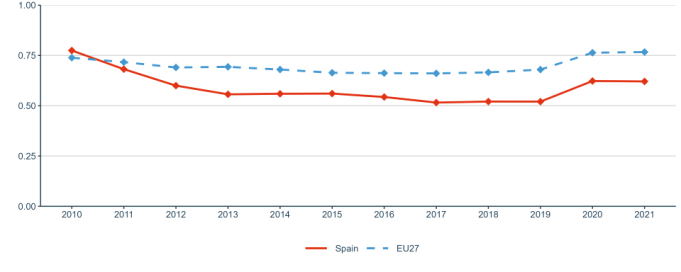

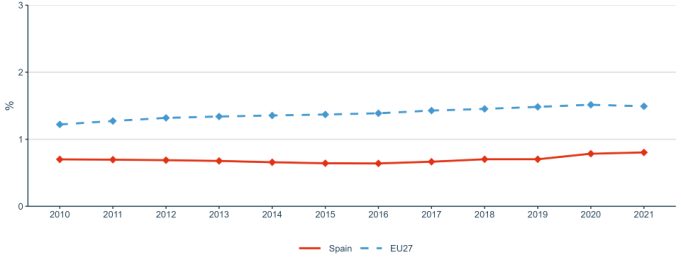
Priority 1: Deepening a truly functioning internal market for knowledge
Sub-priority 1.1: Open Science

Sub-priority 1.2: Research infrastructures

Sub-priority 1.3: Gender equality, equal opportunities for all and inclusiveness


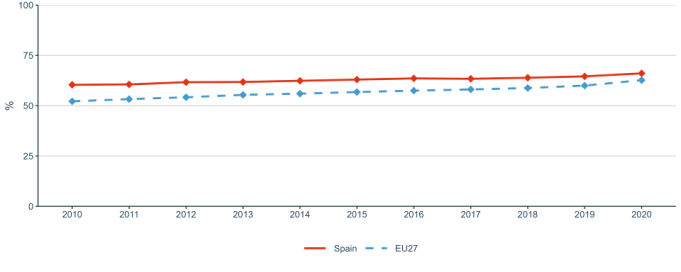


Sub-priority 1.4: Researchers’ careers and mobility and research assessment and reward systems



Sub-priority 1.5: Knowledge valorisation
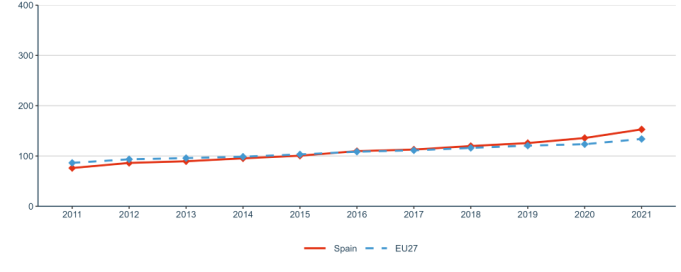
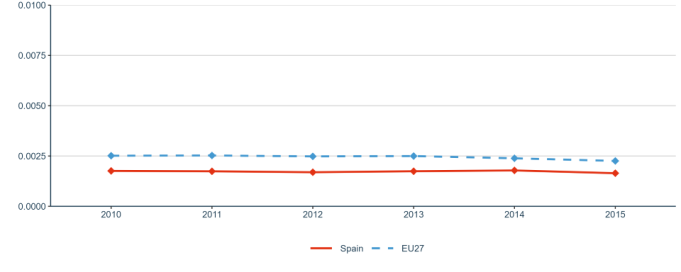


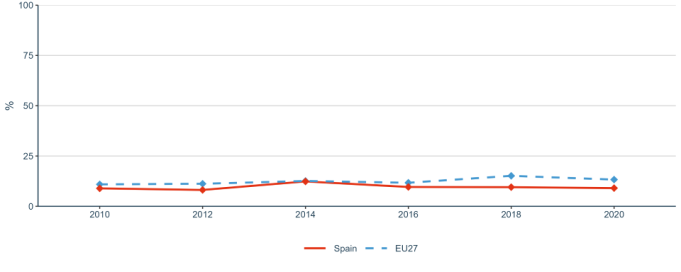
Sub-priority 1.6: Scientific leadership
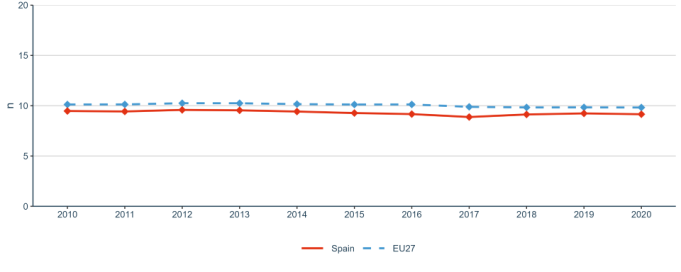
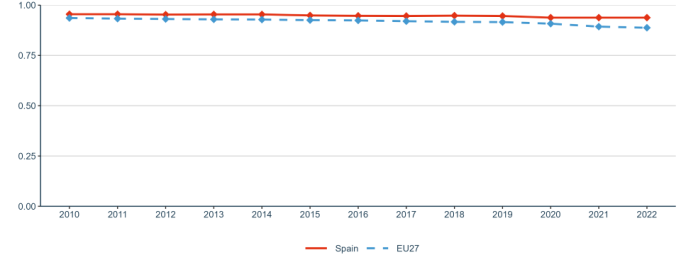
Sub-priority 1.7: Global engagement
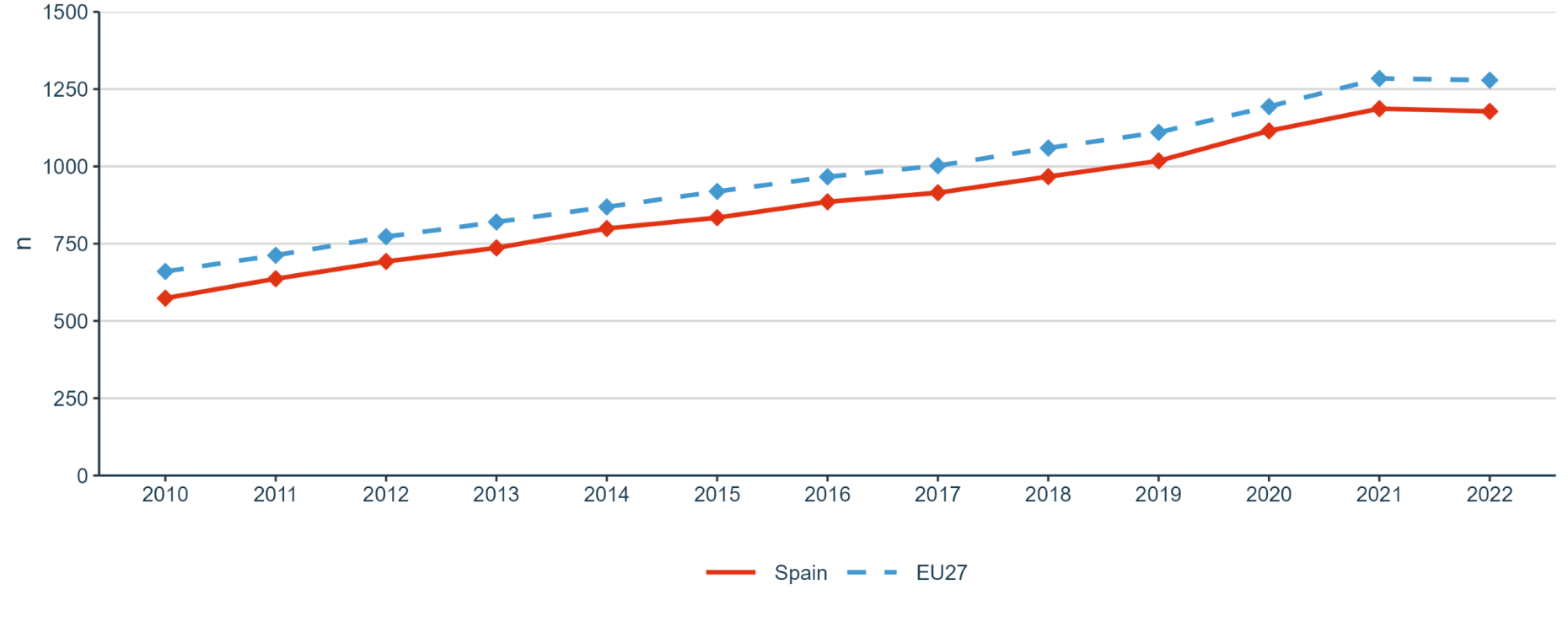

Priority 2: Taking up together the challenges posed by the twin green and digital transition and increasing society’s participation in the ERA.
Sub-priority 2.1: Challenge-based ERA actions





Sub-priority 2.2: Synergies with education and the European Skills Agenda
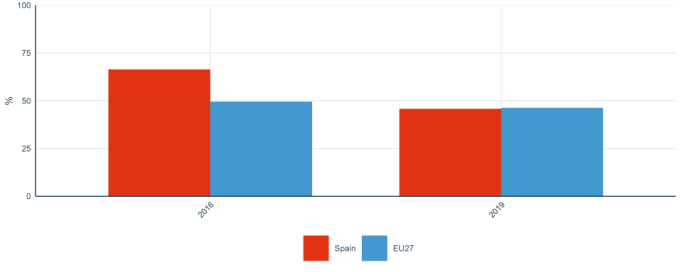
Sub-priority 2.3: Synergies with sectorial policies and industrial policy, in order to boost innovation ecosystems
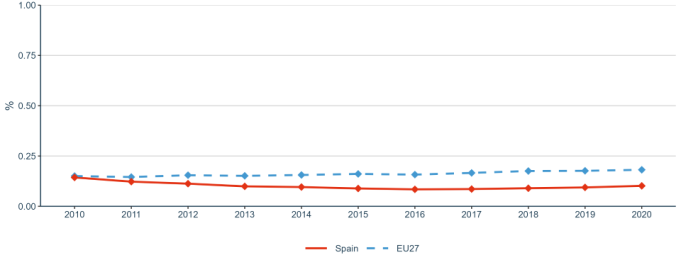
Sub-priority 2.4: An active citizen and societal engagement in R&I in all its dimensions
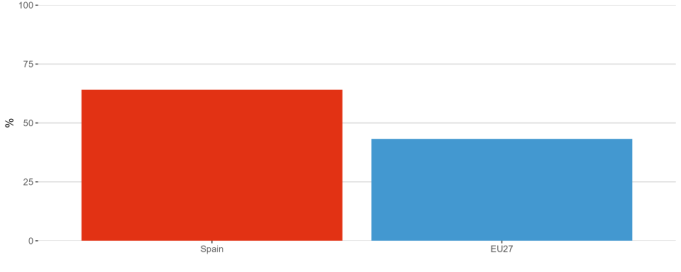

Priority 3: Amplifying access to research and innovation excellence across the Union
Sub-priority 3.1: More investments and reforms in countries and regions with lower R&I performance
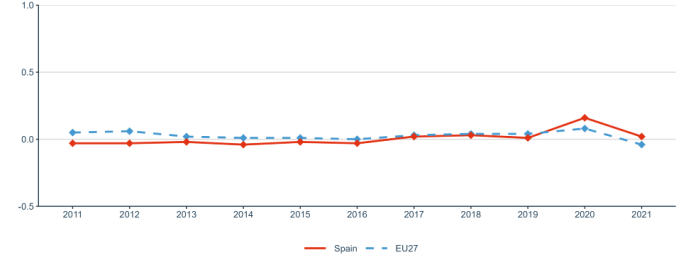
Priority 4: Advanced concerted research and innovation investments and reforms
Sub-priority 4.1: Coordination of R&I investments

